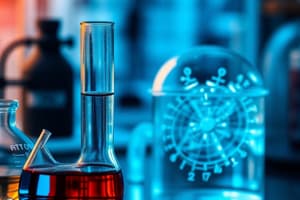Podcast
Questions and Answers
What process is described as the programmed cell death that the body uses to get rid of damaged or unwanted cells?
What process is described as the programmed cell death that the body uses to get rid of damaged or unwanted cells?
- Replication
- Mitosis
- Meiosis
- Apoptosis (correct)
How does DNA fingerprinting help in criminal investigations?
How does DNA fingerprinting help in criminal investigations?
- It determines the genetic relationship between individuals. (correct)
- It analyzes the structure of proteins to identify individual traits.
- It identifies the type of cancer a person has.
- It analyzes the sequence of DNA to identify specific genes.
Which of the following is NOT a characteristic of cancer cells?
Which of the following is NOT a characteristic of cancer cells?
- Uncontrolled cell division
- Ability to migrate to other tissues
- Resistance to apoptosis
- Ability to repair DNA damage (correct)
What is the primary difference between benign and malignant tumors?
What is the primary difference between benign and malignant tumors?
What term describes the process where cancer cells stimulate the growth of new blood vessels?
What term describes the process where cancer cells stimulate the growth of new blood vessels?
Which of the following is considered a common environmental factor that can contribute to cancer development?
Which of the following is considered a common environmental factor that can contribute to cancer development?
What is the main function of the CRISPR-Cas9 system in gene editing?
What is the main function of the CRISPR-Cas9 system in gene editing?
How does the CRISPR-Cas9 system contribute to organ transplantation?
How does the CRISPR-Cas9 system contribute to organ transplantation?
What aspect of the CRISPR-Cas9 system is responsible for guiding the Cas9 enzyme to the target DNA sequence?
What aspect of the CRISPR-Cas9 system is responsible for guiding the Cas9 enzyme to the target DNA sequence?
What is the primary technique used in DNA fingerprinting, which involves cutting DNA into fragments?
What is the primary technique used in DNA fingerprinting, which involves cutting DNA into fragments?
What is the purpose of using a gel electrophoresis technique in DNA fingerprinting?
What is the purpose of using a gel electrophoresis technique in DNA fingerprinting?
Which of the following is NOT a key step in the polymerase chain reaction (PCR) technique?
Which of the following is NOT a key step in the polymerase chain reaction (PCR) technique?
What is the main purpose of polymerase chain reaction (PCR) in biological research?
What is the main purpose of polymerase chain reaction (PCR) in biological research?
How does the process of angiogenesis contribute to the spread of cancer?
How does the process of angiogenesis contribute to the spread of cancer?
Which of the following is an example of an environmental factor that can increase the risk of some types of cancer?
Which of the following is an example of an environmental factor that can increase the risk of some types of cancer?
Flashcards
Scientific Theory
Scientific Theory
An explanation of natural phenomena supported by evidence.
Correlation
Correlation
The relationship between two variables that don't necessarily cause each other.
Causation
Causation
A relationship where one event is the result of the occurrence of another event.
Independent Variable
Independent Variable
Signup and view all the flashcards
Dependent Variable
Dependent Variable
Signup and view all the flashcards
Experimental Treatment
Experimental Treatment
Signup and view all the flashcards
Control Treatment
Control Treatment
Signup and view all the flashcards
Bias
Bias
Signup and view all the flashcards
Cancer
Cancer
Signup and view all the flashcards
Benign Tumor
Benign Tumor
Signup and view all the flashcards
Malignant Tumor
Malignant Tumor
Signup and view all the flashcards
CRISPR
CRISPR
Signup and view all the flashcards
Transcription
Transcription
Signup and view all the flashcards
Translation
Translation
Signup and view all the flashcards
Gene
Gene
Signup and view all the flashcards
Study Notes
Science and the Scientific Method
- Science is limited to falsifiable theories; they must be testable and potentially proven false.
- A theory is an explanation of a natural phenomenon supported by evidence.
- Scientists do not prove hypotheses; they accept, reject, or modify them based on testing and evidence.
- Correlation is the relationship between two things, where one does not cause the other.
- Causation is where one thing directly causes another.
- Proper experimental design includes experimental and control groups, independent and dependent variables.
- Biases, small sample sizes, and flawed experimental design can lead to incorrect conclusions.
- Statistics provide tools for data analysis, collection, and interpretation in scientific studies.
- Pseudoscience claims, beliefs, or practices that mimic science but lack the scientific method.
- Evaluate scientific claims by considering credentials, potential biases, fund sources, and supporting evidence from reputable secondary sources.
DNA and Replication
- DNA (deoxyribonucleic acid) is the foundation of genetic coding and a long, linear molecule composed of nucleotides.
- DNA structure: A double helix with a sugar-phosphate backbone and base pairs (A-T, C-G).
- Base pairs are linked by weak hydrogen bonds.
- Each nucleotide contains a phosphate group, a deoxyribose sugar, and a nitrogenous base.
- DNA is packaged into chromosomes to keep it organized within the nucleus.
- Chromosomes consist of a single DNA molecule that contains genes.
- Chromosomes have sister chromatids that are identical copies, linked together at the centromere.
- Homologous chromosomes are pairs of chromosomes (one from each parent) with the same genes.
- Homologous chromosomes have the same genes but possibly different alleles (versions).
- Sister chromatids are identical copies of a chromosome formed during DNA replication.
Protein Synthesis
- Protein synthesis involves transcription (DNA to mRNA) and translation (mRNA to protein).
- mRNA carries the genetic code from DNA to the ribosome.
- tRNA brings amino acids to the ribosome for protein assembly.
- rRNA forms the ribosome and facilitates protein synthesis.
- Transcription creates a complementary mRNA copy of a DNA sequence.
- Translation uses the mRNA code to assemble a polypeptide chain.
DNA Replication
- DNA replication occurs during the S phase of interphase.
- Helicase unwinds the DNA double helix.
- Primers are added to initiate DNA synthesis.
- DNA polymerase adds nucleotides to the new strands.
- Two identical DNA double helices result from the process.
- This ensures each new cell receives a complete set of DNA.
Cell Division and Mitosis
- Mitosis is the process of cell division that produces genetically identical daughter cells.
- The stages of mitosis include prophase, metaphase, anaphase, and telophase.
- At the end of mitosis there are now two resulting daughter cells.
- Chromosomes condense and become visible during prophase.
- During metaphase, condensed chromosomes align along the middle of the cell.
- Sister chromatids separate and move to opposite poles of the cell during anaphase.
- New nuclei form around separate sets of chromosomes in telophase.
- This cell division is important for growth, repair of tissues, and asexual reproduction.
Cancer
- Cancer results from uncontrolled cell division.
- Uncontrolled cell division commonly leads to the formation of tumors.
- Tumors can be benign (non-cancerous) or malignant (cancerous).
- Cancer cells often undergo angiogenesis to obtain nutrients.
- Cancer involves mutations and uncontrolled growth.
CRISPR
- CRISPR is a powerful gene-editing tool.
- It allows scientists to precisely target and modify specific DNA sequences.
- It involves a guide RNA, Cas9 enzyme, and precise mechanisms, leading to modifications
- This technology may lead to advancements in gene therapy and other applications.
DNA Fingerprinting
- DNA fingerprinting uses unique DNA patterns to identify individuals.
- Techniques involved include PCR, restriction digests, and gel electrophoresis; producing a unique banding pattern.
- It uses specific sequences of DNA to differentiate individuals.
- This can aid in forensic science, paternity testing, and conservation efforts.
Studying That Suits You
Use AI to generate personalized quizzes and flashcards to suit your learning preferences.
Related Documents
Description
Test your knowledge on the principles of science and the scientific method. This quiz covers crucial concepts such as falsifiability, correlation vs. causation, and the importance of proper experimental design. Evaluate your understanding of biases, statistics, and the distinction between science and pseudoscience.




